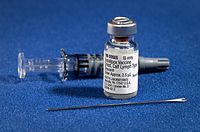
Photo from wikipedia
Development of a successful blood-stage vaccine against Plasmodium falciparum malaria remains a high priority. Immune-epidemiological studies are effective tools for the identification of antigenic targets of naturally acquired immunity (NAI)… Click to show full abstract
Development of a successful blood-stage vaccine against Plasmodium falciparum malaria remains a high priority. Immune-epidemiological studies are effective tools for the identification of antigenic targets of naturally acquired immunity (NAI) against malaria. However, differences in study design and methodology may compromise interstudy comparisons. ABSTRACT Development of a successful blood-stage vaccine against Plasmodium falciparum malaria remains a high priority. Immune-epidemiological studies are effective tools for the identification of antigenic targets of naturally acquired immunity (NAI) against malaria. However, differences in study design and methodology may compromise interstudy comparisons. Here, we assessed antibody responses against intact merozoites and a panel of 24 recombinant merozoite antigens in longitudinal cohort studies of Ghanaian (n = 115) and Indian (n = 121) populations using the same reagents and statistical methods. Anti-merozoite antibodies were associated with NAI in both the Indian (hazard ratio [HR] = 0.41, P = 0.020) and the Ghanaian (HR = 0.17, P < 0.001) participants. Of the 24 antigen-specific antibodies quantified, 12 and 8 were found to be protective in India and Ghana, respectively. Using least absolute shrinkage and selection operator (LASSO) regression, a powerful variable subselection technique, we identified subsets of four (MSP6, MSP3.7, MSPDBL2, and Pf12) and five (cMSP33D7, MSP3.3, MSPDBL1, GLURP-R2, and RALP-1) antigens that explained NAI better than the individual antibodies in India (HR = 0.18, P < 0.001) and Ghana (HR = 0.31, P < 0.001), respectively. IgG1 and/or IgG3 subclasses against five antigens from these subsets were associated with protection. Through this comparative study, maintaining uniformity of reagents and methodology, we demonstrate that NAI across diverse geographic regions may result from antibodies to multiple antigenic targets that constitute the peripheral merozoite surface protein complexes.
Journal Title: Infection and Immunity
Year Published: 2020
Link to full text (if available)
Share on Social Media: Sign Up to like & get
recommendations!